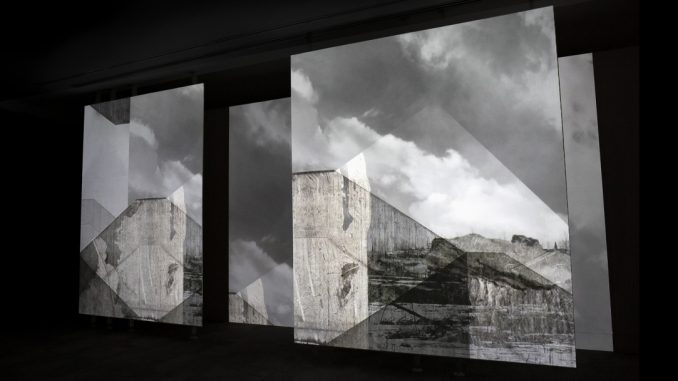
Shelsea Deravil (shderavil@ursinus.edu)
Ursinus College’s Berman Museum of Art recently began exhibiting Shannon Collis: Strata, a “multisensory installation by Canadian artist Shannon Collis, [that] immerses visitors in an environment of deep sonic resonance and dynamic moving images… explor[ing] complex intersections of the social, the economic, and the environmental through contrasts between natural landscape and human industry, while highlighting nature’s persistence in the face of industrial exploitation,” according to the Berman’s website. Some of Collis’ other recent works are the “Kiewa,” “Singular Space,” “Atlas,” and “Iterations,” all of which focus on examining humans’ perception in multiple sensory forms and distinguishing between visual and aural phenomena.
Collis came to the attention of the Berman Museum senior staff during a showing of her artwork at “Grizzly Grizzly” in Philadelphia, and she was subsequently invited to air an exhibition of some of her work. Students minoring in museum studies and taking the “Student Curatorial Seminar” course came together to participate in the installation, curation, and programming of the exhibit.
Kristen Cooney ’22, Justin Mitchell ’22, and Katie Sanfield ’23, were among those students. Sanfield is currently producing the podcast mini-series for the exhibit, with the first episode to be posted in late February and the entire series on the Berman website afterward. Mitchell has been documenting the installation process and exhibition content, work which will also be available online sometime in February. Cooney is in charge of the virtual soundwalk interview between herself and Collis, about Collis’ artistic process, inspirations, and the methodologies behind her most recent work. The interview is set to be published on the Berman website in mid-March.
Other contributors to the exhibit include associate professor of art history Dr. Deborah Barkun, assistant professor of art history Prof. Meghan Tierney, and Berman Museum operations manager Betsy Witt.
The Strata exhibition is an amalgamation of contemporary art and museum space, which allows it to challenge the definition of art, especially because the art is enhanced through interdisciplinarity with environmental studies and socio-economics. “I believe Strata strongly utilizes an environmental lens, creating a unique dialogue between two fields that feel inherently separate,” Cooney said. “It sheds light on the enormity of the human-to-nature relationship but uses artistic and creatively chosen audio-visual sensorial elements to construct an immersive space that we may interpret by using our senses.”
The application of the environmental field demonstrates how people can approach an environment through a curation of chosen panels, sounds, and projections. All choices are carefully made to enhance one’s observations and, ultimately, worldly perspective.
“The most important takeaway… from this exhibition [is] the enormous scale at which humans operate and… by which we are connected with the earth,” Cooney added. “Strata constructs a manner by which terrestrial earth feels vast and human activity on it feels larger. There are a lot of social constructions around how we perceive the natural world that I think require deeper thought, and that Strata requires of a viewer’s attention.”
The Strata exhibition began its debut on Jan. 22 and will complete its run on May 15, 2021.
